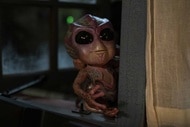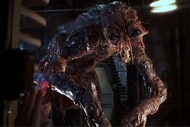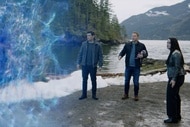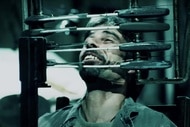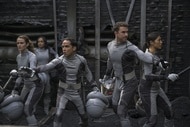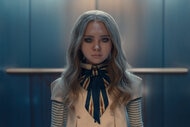Create a free profile to get unlimited access to exclusive videos, sweepstakes, and more!
19 queerest moments of 20-BI-teen

What could follow 20-Gay-teen except for 20-Bi-teen, a designation genre lived up to this year. It has indeed been a very bisexual+ year — you’ll see more than a few bisexual+ moments on this list — but it’s also been a trans, lesbian, gay, nonbinary, polyamorous, and queer year.
From TV to movies to comic books, we have so much awesomeness to celebrate. We’ve seen heroes become revolutionaries, demons become lovers, screwups become P.I.s. There have been queer moments in fiction and IRL that have made us super thirsty. There have been openly nonbinary and transgender characters boldly accepting who they are. We’ve seen extraordinary feats of love and loving expressions of ordinary, everyday queer commitment and relationships.
2019 has been a banner year for queer representation in genre. Not all of that queerness has been perfect, but we’ve rounded up some of the very best moments.
01. Lucifer’s Mazikeen comes to grips with her feelings for Eve—yes, that Eve
Lucifer turns out to be a surprisingly bisexual+ series, especially as the series has worn on. While we’ve seen the devil himself with many a partner, Season 4 allowed Mazikeen aka Maze to explore her sexual attraction to another woman, Eve, the first woman and Lucifer’s ex. (Turns out the snake was a metaphor for Lucifer’s own snake, as it were.) Perhaps more importantly, Maze realizes she wants something more than sex with Eve, who is also bisexual. For a demon who is learning how to live in our world, it’s a BFD to realize Maze wants something more, something real, something that will help her grow. Even though these two babes haven’t worked things out so far, their mutual attraction and healthy communication bring important representation to Lucifer.
02. Ruby Rose destroyed us as Batwoman
We met Ruby Rose’s Kate Kane aka Batwoman back in December 2018, but hoo buddy, did she come into her own in 2019. Rose’s Kane is mouthy, powerful, and decidedly not the Bat you’re used to. Not only is Kane a lesbian, but she’s out, proud, and really unconcerned with other’s opinions of her. Batwoman itself is laudable for its representations of complicated queer relationships and living a double life as someone who has been committed to the truth of who she is — regardless of the cost. In reality, all of that is the icing on the cake that is watching a genderfluid lesbian play a lesbian superhero who is great at what she does, conflicted about the state of the world, and finally ready to kick some ass.
It’s also worth noting that Ruby Rose redefines sexy in the cowl (particularly when she takes off her wig). I mean, just look at her. E-effing-GADS.
03. The Tale for Steven tells a trans self-love story and confirms Steven Universe’s gender identity
“What are you doing? You’re holding the book upside-down!” says White Diamond on the first page of The Tale of Steven, the picture-book adaptation of “Change Your Mind,” from Season 5 of Steven Universe. “Read it like THIS!” she commands the reader from the upper margin of the book where she is the one who appears to be upside-down. What unfolds from there is a gently-evolving plot about Steven, his mother Pink Diamond/Rose Quartz, how White Diamond views him, and how he came to understand himself and his gender identity. It’s a touching story unlike anything I’ve ever read, particularly in how it handles Steven’s self-doubt and confusion around his gender identity in the face of millennia-old adults who are certain they know who he is.
Furthermore, the picture book lays to rest any remaining doubts about Steven’s gender identity: he is trans, he is gender non-conforming, and he is fiercely him.
04. Stumptown gave us a relatable, messy bicon in Dex Parios
Stumptown centers on Dex, a veteran with PTSD that trips face-first into becoming a private investigator — but falling face-first into things is kind of Dex's MO. As she screws, drinks, and fights her way through her cases, it's hard not to fall head over heels for Dex alongside the women and men that fall for (and sleep with) her. Not only does Cobie Smulders deliver a commanding performance, but the writing on the series centers a broad lens on what it means to be a person in Portland — expanding the narrative from solely being about white people to including Indigenous folks, Latinx folks, and Black folks all trying to make a living in one of the whitest cities in the country.
And when it comes to representing bisexuality, Stumptown creates a world where Dex is allowed to be openly queer and openly messy. It's always a gamble to engage with stereotypes of people while representing those people, but Stumptown manages to give us both a Dex who drinks too much, who cheats and sleeps around, who is emotionally unavailable and a Dex who loves her chosen family fiercely, who grapples with what she's lost, and who is indomitable.
05. Nico Torterella serves buff nonbinary goodness while preparing to star in The Walking Dead: The World Beyond
Nonbinary actor Nico Tortorella made news earlier this year when they were cast in the 2020 series The Walking Dead: The World Beyond. Tortorella will play Felix, a character driven by their honor to protect themself and others. (While I’m not sure Felix uses they/them pronouns, Tortorella does, so I’m using those until I hear otherwise.) The World Beyond follows the first generation of survivors to live their entire lives from birth during the zombie apocalypse recounted in the original The Walking Dead. While that’s all well and good — and actually sounds pretty compelling — it is Tortorella’s IRL accounts of training for the role in all their nonbinary goodness that earn their spot on this list. Tortorella has shared not only enticing images of their SWOLness, but consistent messages about how nonbinary folks can appear in many ways. We cannot wait to see them in action fighting zombie hordes.
06. Nancy Drew finally has an openly queer character: Bess
After 85 years, there is finally a queer character in the main cast of Nancy Drew, thanks to the CW adaptation of the much beloved feminist detective novels. Bess Marvin (Maddison Jaizani) was the boy-focused straight friend of the protagonist in the books, but has been reimagined as an out lesbian on the series. Better than that is the fact that Bess gets to have a romantic storyline where she dates — and kisses! onscreen! — a cutie pie named Lisbeth. Fans of the series are so happy with the reimagining of Bess that they’ve given her the moniker “Bessbian.”
07. Brie Larson and Tessa Thompson made us so, so thirsty at Ace Comic Con
Avengers: Endgame stars Brie Larson aka Captain Marvel and Tessa Thompson aka Valkyrie have queered their friendship all year by exchanging flirty tweets stanning MarVal slash fanart and generally supporting fans’ emphatic shipping of the characters they portray in the MCU. Their delightful interactions have fueled the flames of slash fandom, but the real icing on the cake came at Ace Comic-Con. An audience member called out “lesbians” in response to a question posed to Larson and Thompson on their panel. After Thompson described being excited for Natalie Portman to wield the hammer in Thor: Love and Thunder, Larson said, “How do I top lesbians?” Without hesitation, Thompson said, “I’m sure the lesbians could show you right after this panel.” The audience erupted into laughter and cheering, perfectly predicting how the entirety of the queer internet would react.
08. Mystique and Destiny smooch it up at long last
Mystique and Destiny may just be the first queer couple in Marveldom. Over the last 40 years, though, their queerness has been relegated to the world of implication — where fans often find queer love represented. Sure, they touch hands and gaze longingly at one another. Sure, Mystique lives as a man for a while, utilizing her ability to straight-pass to keep her and Destiny safe. Sure, they adopt Rogue and raise her. BuT THaT DoesN’t Make thEM QuEeR?!?!?!
Well, say goodbye to deniability. In History of the Marvel Universe Volume 2, we finally see the two not just as domestic partners, but as smoochy-smoochy lovers. The in-panel acknowledgment is important just for what it is, but the inclusion of these panels in this particular volume is all the more affirming. The History of the Marvel Universe volumes are geared toward creating a definitive history, so finally, finally Mystique and Destiny’s loving, intimate relationship is canonical, acknowledged, and valued.
09. She-Ra and the Princesses of Power’s Double Trouble becomes the first nonbinary cartoon character voiced by a nonbinary actor
She-Ra and the Princesses of Power is a pretty freaking queer TV show. From the rainbow goodness of the credits to the queer couples lovingly bantering onscreen to the coded queerness of the main characters—villains and heroes alike—the queerness is palpable. Season 4 kicked it up another notch by adding nonbinary character Double Trouble to team baddie. Even more exciting is that Double Trouble is voiced by nonbinary activist, author, and actor Jacob Tobia, making them the first nonbinary actor to voice a nonbinary cartoon character. Double Trouble is a shape-shifting mercenary who prides themself on being quite the actor. They are a dramatic, lizard-like character who sews the seeds of destruction among She-Ra’s heroes, all while helping Catra and her team. Compelling villains are She-Ra’s whole bag — and Double Trouble makes a perfect addition.
10. Two jocks find love in a desperate place on Daybreak
What would happen if nuclear and biological warfare decimated the world, killing all the adults? Well, Netflix’s Daybreak suggests that Gen Z wouldn’t be able to save us, but they’d be just fine without us. Instead of destabilizing high school cliques, the end of the world simply elevates the already strong, making cheerleaders into feminist Cheermazons, jocks into Mad Maxian bullies, and so on. Everyone has to choose one and live with the rules of that in-group. A handful of children try to live outside these communities, including Wesley (played by queer actor Austin Crute), a former jock turned self-described Ronin on the path to redemption. When he rescues the leader of The Jocks, Turbo, from a cannibal, the two ex-boyfriends reconnect and spend the rest of the season trying to figure out their deal. Cue many cute cuddle/sex sessions, tender kisses between two beefy teens, and a duel to the "death" (that ends in glitter).
11. Sara and Ava fight for love on Legends of Tomorrow
Legends of Tomorrow is one of the weirdest and queerest shows on TV. And while 2018’s queer kiss that saved the universe was certainly a showstopper, 2019 found Legends in so queer a place that choosing a single moment turns out to be quite the challenge. The evolution of Avalance—the relationship between Captain Sara Lance and Director Ava Sharpe—is a real stand out, though. Not only do Sara and Ava learn how to choose one another in extreme circumstances like when a demon is trying to possess Ava but in the more mundane situations like figuring out how to be in a committed long-space-time-continuum relationship.
Season 4’s “The Eggplant, The Witch, and the Wardrobe” brought the mundane and the supernatural together as Sara and Ava had to make their way through Ava’s purgatory which just so happens to be Faux-kea. To escape purgatory and save Ava’s soul, they must build a wardrobe, clean a very dirty kitchen, and select a mattress with an appropriate warranty. What they really do in that time, though, is face their hesitations about commitment, decide they both look hot AF even in 50 years, and commit themselves to make their relationship work. It’s not the shiny new kind of queer love, but a more simple, abundant, and stable kind of queer love — and it’s wonderful to see that kind of commitment also represented on TV.
12. Xena and Gabrielle achieve canonical relationship bliss thanks to Vita Ayala
Nonbinary comic writer Vita Ayala took the helm of Xena: Warrior Princess in 2019 alongside artist Olympia Sweetman and rebooted our favorite bisexual warrior princess and warrior bard. The whole run has been a delightful romp through the precarious societies of mortals and the Gods that really love to eff with them. While the rise of Discord and her subsequent derailing of the lives of Xena and Gabrielle drips in queerness, it is the relationship between Xena and Gabrielle that makes this list. Throughout the run of the series, Xena and Gabrielle teeter between gal pals and Ga(y)l Pals, but the comic firmly situates the two as lovers, showing them share a bed, kiss, and live as wives. Though the two have long been claimed as queer idols, it’s lovely to see them healthily in love and caring for one another.
13. The X-Men are polyamorous
2019’s X-Men Issue #1, written by Jonathan Hickman and drawn by Leinil Francis Yu, established that Jean Grey, Scott Summers, and Wolverine are living together in what the internet has decided to be polyamorous bliss. The evidence for this assumed arrangement? Well, it just so happens Jean’s room is situated between and adjoined with Scott’s and Logan’s in a way no other rooms are connected. On top of that, House of X Issue #6 contains the above panel showing Logan merrily draping his arms over both Jean and Scott. And the final icing on the cake that is this polycule? The reveal of Mister Sinister’s secrets in Powers of X Issue #4, written by Jonathan Hickman with art by R.B. Silva, implying a polyamorous arrangement of these three powerhouses — plus the inimitable Emma Frost. All this implication makes it easy to see why the internet went wild over this X-Men quad — or who knows, moresome.
14. Runaways explored an (imaginary) queer wedding
The relationship between Runaways superheroes Karolina Dean and Nico Minoru has been sweet and tumultuous, making it a pretty accurate reflection of teenage romance. Of course, their connection is under constant strain since the two have run away together, come out together, and live together — in opposition of their super villain parents. Season 3, the series’ final season, has continued to explore the relationship between these two cuties, even offering fans a glimpse of a future filled with bliss. That’s right: the kids got hitched. Well, kind of.
Season 3 opens with Karolina trapped in a pod that allows her to live out her deepest fantasy: marrying Nico, which she does with a huge smile and a happy heart. Even though the wedding isn’t real, which Karolina realizes eventually, it represents a low-stakes exploration of two queer people falling in love and growing older together. Also, for the record, it would have been really weird if the two had actually gotten married since they’re both still way too young. The wedding may be a figment of Karolina’s imagination, but the devotion between Karolina and Nico is very, very real.
15. Anissa Pierce becomes Blackbird on Black Lightning
On Black Lightning, Anissa has often differed from her father in her ideas of how to use her powers for the people of Freeland. In Season 3, though, she has taken her commitment to bettering the lives of others to new heights. And, since she can no longer operate under the identity of Thunder, she chooses to become Blackbird, a revolutionary working against a militaristic covert governmental organization to protect the metahumans of Freeland. It’s an empowering moment not only because it shows her stepping out of her father’s shadow, but also because it shows a superpowered Black lesbian using all of her strength and might to protect people like her. So many superhero stories have heroes living lives removed from the everyday struggles of our world — and Blackbird is the exact opposite: a hero who understands discrimination at so many levels that she can’t remain complacent.
16. Supergirl’s Dreamer comes out as trans on national TV
Nicole Maines became the first trans actor to portray a trans superhero on TV in 2018 — and in 2019, that superhero, Dreamer, came out on live TV. Season 4’s “American Dreamer” finds Dreamer aka Nia Nal stepping up to play hero numero uno to National City due to Supergirl needing to clear her name. Kara Danvers (not in her super persona) interviews Dreamer live and during her moving interview, Dream comes out. “My parents believed that humans and aliens could co-exist, and I am living proof of that. But growing up wasn’t easy,” Dreamer tells Danvers. “I am also a trans woman. I’m different, Ms. Danvers, but so is everybody. And I don’t know when that became such a bad thing. The greatest gift we can give each other is our authentic selves, and sharing that — sharing our truth — is what will make us strong.”
It's a big moment for the series and a powerful reminder of just what heroes can be.
17. Angela and Satana flirt and kiss in Strikeforce #2
Featuring a superhero team with two canonically queer characters and a handful of others many queer fans would claim as our own, Strikeforce can’t help but be a cheeky, queer romp of a team up. Working under the leadership of Blade, Angela, Spider-Woman, Spectrum, Wiccan, and Winter Soldier, and Daimon Hellstrom face mystical threats and demonic casinos. And in Strikeforce #2, the queerness gets plain slap happy. Wiccan yells his engagement to the Avenger Hulkling at attractive men he sees, just to make sure everyone is on the same page. Satana Hellstrom flirts with both Blade and Angela — it’s Angela who ends up picking up Satana in a carry that would make even Odin himself blush to get her out of the room. But the real pièce de résistance is a technicolor dream of a smooch between the former Queen of Hel and one-horned (and horny) succubus.
18. Killjoys’ Pree showed he can pull off any style in alterna-Westerly
Killjoys’ fifth and final season appeared in 2019. And, while it was a fantastic final season, it still broke all our Killjoyian hearts. Luckily, we got one final new lewk from the biracial uncle of Westerly, Pree himself. When our heroes are scattered and brainwashed into thinking the world is different at the beginning of Season 5, Pree ends up on the other side of the bar as a killjoy, hunting down bounties. He still has a relationship with Gared — thank the stars — though it seems this new Gared and Pree aren’t out with their relationship. Eventually, their minds get reset and they help with the human resistance, but let’s focus on what really matters here, people. We stan a queero who can rock a variety of outfits that could be described all along the spectrum of feminine and masculinity—and we wouldn’t dare leave Pree off this list one last time.
19. One cutie pie escorts another to a pageant on Legacies
Following in the footsteps of The Vampire Diaries and The Originals, Legacies tells the atypical story of the typical baddies of urban fantasy and how these vampires, werewolves, witches, and more are trained at The Salvatore School. In many ways, their supernatural qualities result in the children being treated like queer folks — some are kicked out of their home for who they are, the townie/special school divide often feels coded as anti-queer. But it doesn’t stop there. The series also features many characters who span the queer spectrum, some openly identifying as bisexual and others simply exploring their attractions. While there are probably dozens of d’aww worthy moments in the series, perhaps the best of 2019 occurs in Season 1’s “Let’s Just Finish the Dance.” When exes slash bisexual+ babes Josie and Penelope finally stop bickering and/or making out while controlled by brain slugs, they make an incredible pair, whether dancing or arguing the finer points of feminism. More importantly, Penelope believes in Josie and encourages her to believe in herself. D’aww.
20. Honorable mention: Oscar Isaac queering Star Wars regardless of Disney’s wishes
We’re not gonna take the time to mourn the erasure of FinnPoe here. We save that ritual for our solstice celebrations. Right here we’re going to give a hearty nod to Oscar Isaac, the human single-handedly queering the Star Wars films. (OK, not really. Fans have been slashing Star Wars for years.) It’s a little weird to have an actor talking about how characters should have been queer onscreen on this list — it’s a kind of apophatic queerness — but Isaac’s frustration about and dedication to acknowledging the erasure certainly made a mark on 2019.


















